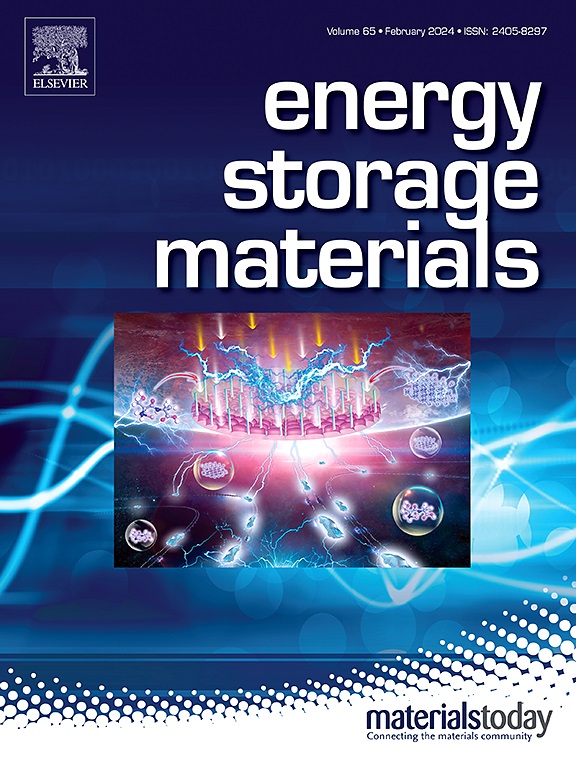Facile Gel Polymer Electrolyte Enabling Fast Charging of Quasi-Solid-State Lithium Metal Batteries at −40°C
IF 18.9
1区 材料科学
Q1 CHEMISTRY, PHYSICAL
引用次数: 0
Abstract
Gel polymer electrolytes (GPEs) are promising for lithium metal batteries (LMBs) due to their high ionic conductivity and excellent mechanical properties. However, conventional GPEs often underperform at low temperatures and high rates. Herein, we develop a low-temperature fast-charging GPE (LFGPE) by incorporating LiPO2F2 as an additive into a LiBF4/DOL/FEC-based precursor. The LFGPE exhibits a high ionic conductivity of 0.49 mS cm−1 (−40°C). Notably, LiPO2F2 participates in Li+ solvation structures at −40°C, competing with poly-DOL and BF4−, which weakens their tight coordination with Li+. Moreover, LiPO2F2 exhibits a narrow gap of HOMO-LOMO energy level, preferentially decomposing and inducing formation of P-containing solid electrolyte interphase (SEI). Thus, the LFGPE system generates inorganic-rich SEI containing Li3PO4, which accelerates Li+ desolvation and Li+ migration across the SEI, improving Li+ transport kinetics and interfacial stability at −40°C. Consequently, Li//LiCoO2 (LCO) cells with the LFGPE yield a high reversible capacity of 128 mAh g−1 at 1 C (−40°C). Impressively, the LFGPE even enables Li//LCO cells to sustain over 200 cycles under 3 C charging/1 C discharging at −40°C. This work offers an effective approach of simultaneously enhancing ion transport kinetics and interfacial stability to develop quasi-solid-state LMBs with low-temperature fast charging capability.

在- 40°C下实现准固态锂金属电池快速充电的易溶凝胶聚合物电解质
凝胶聚合物电解质(GPEs)由于其高离子电导率和优异的力学性能,在锂金属电池(lmb)中具有广阔的应用前景。然而,传统的gpe在低温和高速率下往往表现不佳。在此,我们通过将LiPO2F2作为添加剂加入到LiBF4/DOL/ fec基前驱体中,开发了一种低温快速充电GPE (LFGPE)。LFGPE具有0.49 mS cm−1(−40°C)的高离子电导率。值得注意的是,LiPO2F2在- 40°C时参与Li+溶剂化结构,与poly-DOL和BF4 -竞争,削弱了它们与Li+的紧密配位。此外,LiPO2F2表现出HOMO-LOMO能级的窄间隙,优先分解并诱导形成含p固体电解质界面(SEI)。因此,LFGPE体系生成了含有Li3PO4的富无机SEI,加速了Li+的脱溶和Li+在SEI上的迁移,提高了Li+在- 40°C下的运输动力学和界面稳定性。因此,具有LFGPE的Li//LiCoO2 (LCO)电池在1c(- 40°C)下可产生128 mAh g - 1的高可逆容量。令人印象深刻的是,LFGPE甚至可以使Li//LCO电池在−40°C下,在3℃充电/1℃放电的情况下维持200多个循环。本研究为同时提高离子传输动力学和界面稳定性,开发具有低温快速充电能力的准固态lmb提供了有效途径。
本文章由计算机程序翻译,如有差异,请以英文原文为准。
求助全文
约1分钟内获得全文
求助全文
来源期刊

Energy Storage Materials
Materials Science-General Materials Science
CiteScore
33.00
自引率
5.90%
发文量
652
审稿时长
27 days
期刊介绍:
Energy Storage Materials is a global interdisciplinary journal dedicated to sharing scientific and technological advancements in materials and devices for advanced energy storage and related energy conversion, such as in metal-O2 batteries. The journal features comprehensive research articles, including full papers and short communications, as well as authoritative feature articles and reviews by leading experts in the field.
Energy Storage Materials covers a wide range of topics, including the synthesis, fabrication, structure, properties, performance, and technological applications of energy storage materials. Additionally, the journal explores strategies, policies, and developments in the field of energy storage materials and devices for sustainable energy.
Published papers are selected based on their scientific and technological significance, their ability to provide valuable new knowledge, and their relevance to the international research community.
 求助内容:
求助内容: 应助结果提醒方式:
应助结果提醒方式:


